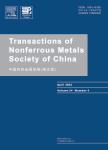Effect of extrusion speed on properties of Cu-5 vol.%TiSnC composite wire fabricated by friction stir back extrusion process
作者机构:Department of Materials Engineering, Babol Noshirvani University of Technology
出 版 物:《Transactions of Nonferrous Metals Society of China》 (中国有色金属学报(英文版))
年 卷 期:2023年
核心收录:
学科分类:080503[工学-材料加工工程] 08[工学] 0805[工学-材料科学与工程(可授工学、理学学位)] 0802[工学-机械工程] 080201[工学-机械制造及其自动化]
摘 要:The present work investigated the effect of axial traverse speed of friction stir back extrusion (FSBE) process on the microstructure, mechanical, electrical, and wear properties of Cu-Ti2SnC composite wire. The FSBE process was performed on the primary composite made by the powder metallurgy method with 5 vol.% of Ti2SnC MAX phase. The results showed that as the extrusion speed increased, the twins formed in the microstructure increased, the Ti2SnC particles became finer, and the interface of bonding of the MAX phase-Cu matrix improved. The Cu-Ti2SnC composite wire fabricated by the rotational speed of 600 rpm and axial traverse speed of 25 mm/min showed maximum hardness, yield strength, and ultimate tensile strength of 132.7 HV, 278.3, and 485.1 MPa, respectively. This finding was due to its stronger interfacial bonding and finer MAX phase particles. Besides, the larger grain size, better interface bonding, and lower porosity resulted in the highest electrical conductivity of 89.21% IASC and least wear rate of 0.0015 mg/m of Cu-Ti2SnC composite wire fabricated by 600 rpm rotational speed and 25 mm/min axial traverse speed.



